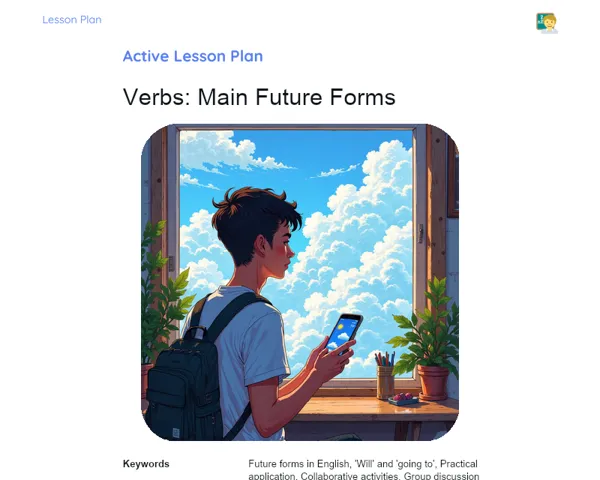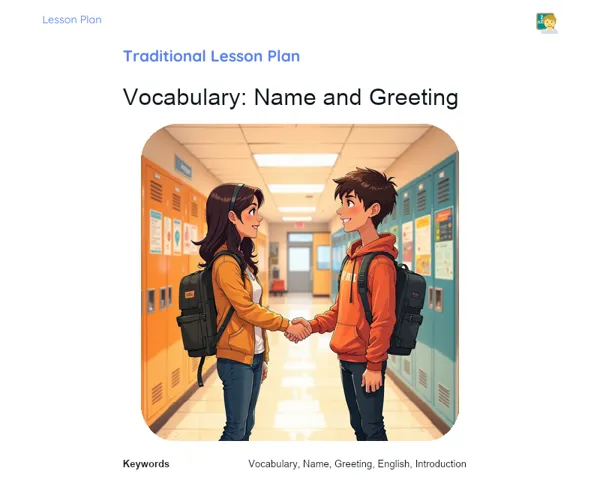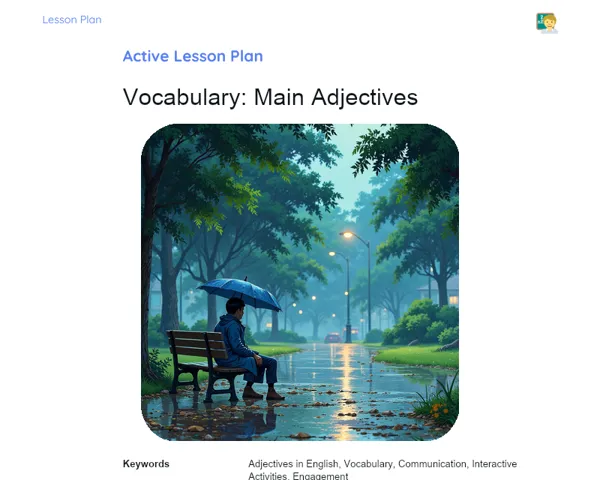Lesson Plan | Lesson Plan Iteratif Teachy | Verbs: to Be
| Keywords | Verb to be, English, Digital Methodology, 6th grade, Social media, Active learning, Digital biographies, Storytelling, Digital escape room, Teamwork, Collaboration, Language fluency, 360° feedback |
| Resources | Mobile phones or computers, Internet access, Online design tool (e.g., Canva), Social media platform or simulation tool, Online escape room platform, Projector or screen for presentations, Note-taking materials (notebook, pen) |
| Codes | - |
| Grade | 6th grade |
| Discipline | English |
Goal
Duration: 10 - 15 minutes
The aim of this stage is to make sure that learners know what the lesson objectives are and grasp the significance of using the verb 'to be' correctly. This is crucial for forming basic sentences and effective communication in English.
Goal Utama:
1. Understand the verb 'to be' and its different forms: am, is, are.
2. Use the verb 'to be' correctly in affirmative, negative, and interrogative sentences.
Goal Sekunder:
- Develop the ability to spot the verb 'to be' in everyday situations like social media and informal chats.
- Improve pronunciation and fluency when using the verb 'to be' across various contexts.
Introduction
Duration: 15 - 20 minutes
This stage aims to energise the students for the lesson theme by connecting the content to their digital lives. By searching for interesting tidbits about the verb 'to be', learners start to engage with the topic and see its relevance. The key questions encourage reflection and revision of prior knowledge, sparking discussions that deepen their understanding of the content.
Warming Up
Kick off with the topic 'Verb to be' by explaining that it's one of the foundational verbs in English, instrumental in expressing states, identities, and characteristics. Then, encourage students to whip out their phones to uncover an interesting fact about the verb 'to be' in a specific context, whether it's a notable quote, a well-known meme, or a popular saying on social media. This connects the lesson content with their digital experiences and makes the learning more relatable and engaging.
Initial Thoughts
1. What are the three forms of the verb 'to be' in the present?
2. How can we use the verb 'to be' to describe who we are?
3. What’s the difference between 'I am', 'You are', and 'He/She/It is'?
4. Can you share an interesting example about the verb 'to be' you found on social media?
5. Why is it key to know and use the verb 'to be' accurately?
Development
Duration: 70 - 80 minutes
This stage aims to provide learners with a practical and enjoyable encounter with the verb 'to be', linking learning to their digital everyday lives while promoting collaboration and creativity. The suggested activities enable students to leverage technology and social media to apply their knowledge in an engaging and contextual way, bolstering their comprehension and fluency with this essential verb.
Activity Suggestions
Activity Recommendations
Activity 1 - Digital Influencers: Crafting Biographies!
> Duration: 60 - 70 minutes
- Goal: Practice using the verb 'to be' in varied contexts while enhancing writing and presentation skills in English, linking their learning to the students' digital environment.
- Deskripsi Activity: In this activity, students will create profiles of imaginary digital influencers using the verb 'to be'. Each group takes charge of crafting a fun and engaging biography, including details like name, age, residence, a defining trait, and a catchy slogan. The bio should mimic a social media post, utilising an online design tool like Canva.
- Instructions:
-
Split the class into groups of up to 5 learners.
-
Ask each group to pick a name and identity for their digital influencer.
-
Assist students in accessing Canva or a similar design tool on their devices.
-
Each group must create a post featuring the influencer's biography, using sentences with the verb 'to be'. Example: 'Her name is Luna. She is 22 years old. She is from Brazil. She is quite creative.'
-
Encourage groups to be imaginative and use visuals, colours, and fonts that make the post appealing.
-
After creation, each group presents their influencer to the class, explaining their creative choices and reading the biography aloud.
Activity 2 - Storytelling on Social Media: A Day in the Life!
> Duration: 60 - 70 minutes
- Goal: Cultivate the ability to structure and convey short narratives in English, employing the verb 'to be' while connecting learning with prevalent practices on social media.
- Deskripsi Activity: Students will craft a series of short stories using the verb 'to be', simulating posts from a fictional character's daily life. They can use platforms like Instagram or Twitter for their posts, complete with photos, hashtags, and comments.
- Instructions:
-
Split the class into groups of up to 5 learners.
-
Each group must conceive a fictional character and outline a day in that character's life, considering various moments throughout the day.
-
Guide students to use a social media platform (or a simulation tool) to generate a series of posts, each depicting a moment of the character's day with the verb 'to be'. Example: 'It is morning. John is at the park. He is joyful.'
-
Encourage the inclusion of visual elements like photos (which can be illustrations or stock images) and relevant hashtags.
-
Each group will share their series of posts with the class and narrate their storyline in sequence.
Activity 3 - Digital Escape Room: The Mystery of the Verb 'To Be'!
> Duration: 60 - 70 minutes
- Goal: Reinforce understanding of the verb 'to be' in a fun and collaborative manner, encouraging teamwork and practical application of learnt knowledge.
- Deskripsi Activity: Students will engage in a digital escape room where they'll need to solve puzzles and tackle challenges that require the accurate use of the verb 'to be'. Utilizing an online escape room platform, groups will collaborate to decipher clues and progress until they unravel the mystery.
- Instructions:
-
Form groups of up to 5 learners.
-
Explain that they'll embark on a digital escape room themed around 'Verb To Be'.
-
Students must access the selected online escape room platform.
-
They will need to tackle a series of puzzles and challenges that demand the correct use of the verb 'to be' for progression. Example: 'Complete the sentence: She ___ a doctor.'
-
Foster collaboration and discussion among groups to ensure everyone grasps the correct usage of the verb.
-
While the objective is to finish first, the activity's emphasis should be on enjoyment and cooperative learning.
Feedback
Duration: 20 - 30 minutes
This stage aims to allow students to reflect on their learning, share insights and experiences, and receive constructive feedback from their peers. This strengthens their grasp of previously covered topics and fosters a collaborative and supportive environment, which is vital for their academic and personal growth.
Group Discussion
⭐ Group Discussion: Facilitate a group discussion for all students to share what they learned from the activities. Start the discussion with this brief script: 'Alright everyone, let's share our takeaways from the activities. Let's chat about the challenges we faced, what we discovered, and our experiences using the verb 'to be' in different digital contexts. Each group can kick off with a brief presentation of what they did, and then we’ll have a group discussion.'
Reflections
1. 🔍 Reflection Questions: 2. 1. How do you think using the verb 'to be' influences how we communicate on social media? 3. 2. What were the biggest challenges you encountered when using the verb 'to be' during the activities and how did you navigate them? 4. 3. How did these activities help bridge the learning of the verb 'to be' with your digital experiences and everyday lives?
Feedback 360º
📝 360° Feedback: Instruct learners to conduct a 360-degree feedback session. Explain that each student should receive constructive and respectful feedback from the group members they worked with. Encourage the class to focus on positive highlights and suggestions for improvement. For instance: 'What did you excel at?', 'What could be improved?', 'How did you contribute to the teamwork aspect?'
Conclusion
Duration: 10 - 15 minutes
✨ Purpose: The conclusion stage aims to cement students' understanding, highlighting the significance of the content covered and its practical applications in their lives. It also reinforces the connection between the subject matter and today's digital environment, ensuring that learners leave the lesson appreciating the relevance of the verb 'to be' and feeling motivated to utilize this knowledge in their daily interactions.
Summary
🌟 Lesson Recap: Today, we explored the fantastic world of the verb 'to be'! We uncovered its three key forms: am, is, and are. With the help of imagined digital influencers and fun escape rooms, we learned how crucial this verb is for describing identities, states, and traits. 'My name is Carlos. I am joyful. We are learning!' - simple, entertaining, and incredibly useful! 🚀
World
🌍 In the World: The verb 'to be' pops up everywhere in English, from social media to scripts in movies and shows. It's vital for effectively expressing identities and states, helping our learners feel more confident in navigating and engaging with the global digital landscape. Mastering the use of 'to be' is your ticket to understanding and relating to the world around us. 📱
Applications
📝 Applications: Knowing and correctly using the verb 'to be' is essential for everyday communication, whether in social media updates, classroom presentations, or even conversations with friends from abroad. This knowledge opens doors for new learning and interactions in English, which is crucial in our modern, technology-driven world.



